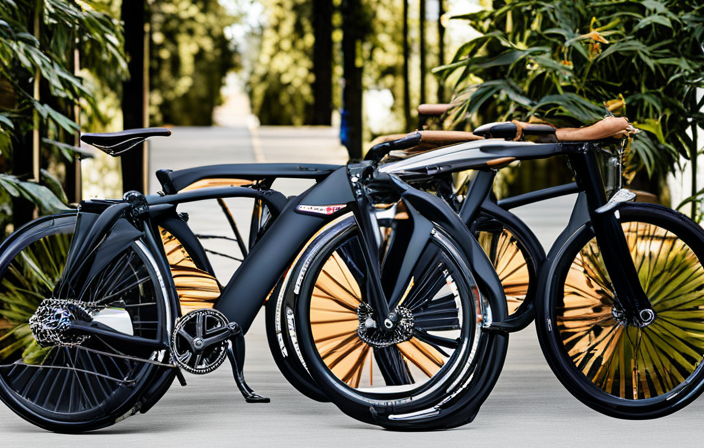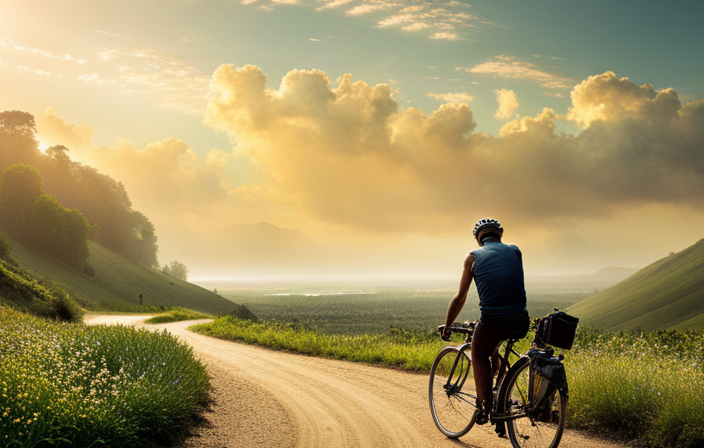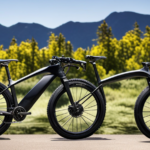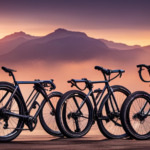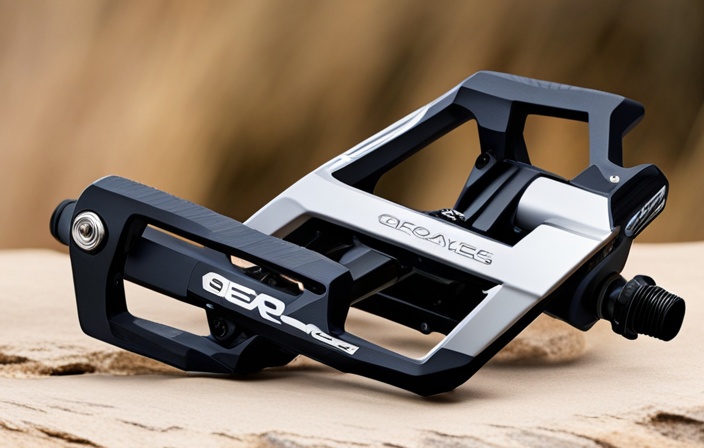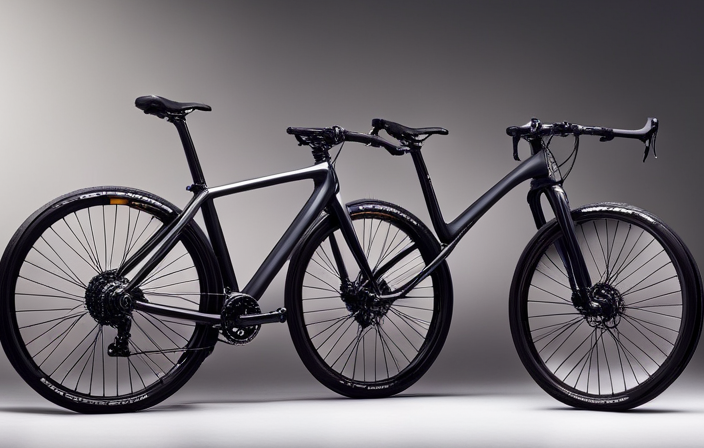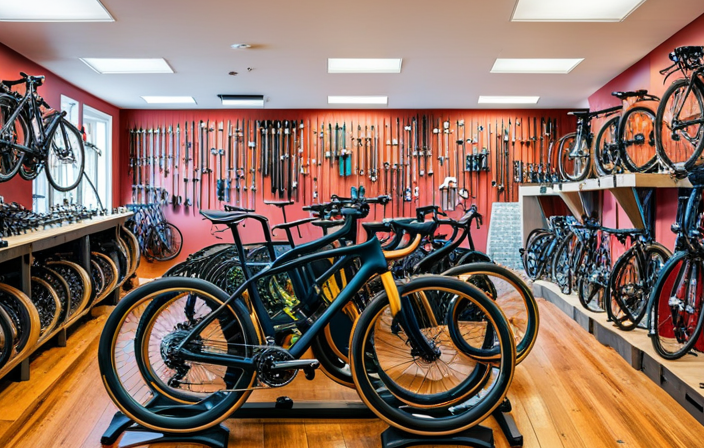Are you prepared to explore gravel trails and take on the open road? The choice of bike can greatly impact your riding adventure. With a variety of options to consider, it may seem daunting to select the perfect one for you. But fear not, as I am here to assist you on this exciting journey.
In this article, we will explore various types of bikes that are perfect for both pavement and gravel trails. So strap on your helmet and let’s dive in!
Key Takeaways
- Gravel bikes and hybrid bikes are versatile options suitable for both pavement and gravel trail riding.
- Wider tires provide better traction on loose surfaces and are ideal for off-road adventures on rough terrains.
- Lightweight construction and aggressive geometry of road bikes offer faster speeds and better handling on pavement.
- Electric bikes offer motor assistance for easier rides on both pavement and gravel trails.
Road Bikes
You’ll need a road bike if you plan on riding on pavement and gravel trails. Road bikes are designed specifically for this type of terrain, offering several advantages over other types of bikes.
One of the main advantages of road bikes for pavement riding is their lightweight construction. This allows for faster speeds and easier maneuverability, making them perfect for long-distance rides on smooth surfaces.
When it comes to choosing the right size road bike for optimal performance, there are a few key factors to consider. First, you need to determine your inseam measurement, which will help you find the correct frame size. A proper fit ensures that you can maintain an efficient and comfortable riding position.
Additionally, it’s important to look at the geometry of the bike. Road bikes typically have a more aggressive geometry compared to other types of bicycles. This means they have a shorter wheelbase and a steeper angle between the seat tube and head tube. These features contribute to better handling and increased power transfer while pedaling.
Now let’s transition into talking about gravel bikes, which are another popular option for riders who want versatility in their cycling adventures without compromising performance or comfort.
Gravel Bikes
For pavement and gravel trails, a good option is to go for a gravel bike. These bikes are specifically designed to handle both smooth roads and rougher terrains like gravel trails. Unlike road bikes, which are optimized for speed on paved surfaces, gravel bikes offer several advantages that make them ideal for mixed terrain riding.
One of the main advantages of a gravel bike is its versatility. It can handle different types of surfaces with ease, allowing you to explore various terrains without limitations. The wider tires provide better traction on loose surfaces like gravel or dirt, ensuring a stable ride.
Compared to road bikes, gravel bikes typically have a more relaxed geometry. This means they offer a more upright riding position, making them comfortable for longer rides on uneven terrain. Additionally, most gravel bikes come equipped with disc brakes that offer better stopping power in all weather conditions.
To give you an idea of the benefits of a gravel bike compared to other options, here is a comparison table:
| Gravel Bike | Road Bike |
|---|---|
| Versatile design | Optimized for speed |
| Wider tires for better traction | Narrow tires suitable only for pavement |
| Relaxed geometry for comfort | Aggressive geometry focused on aerodynamics |
| Disc brakes for reliable stopping power | Rim brakes with less stopping power |
Now let’s move on to the next section where we will discuss hybrid bikes without losing momentum.
Hybrid Bikes
When it comes to finding a bike that is versatile and suitable for both pavement and light gravel trails, a hybrid bike is the way to go.
I have found that hybrid bikes offer the perfect balance between road and off-road capabilities, allowing me to ride comfortably on various terrains.
One of the key features of a hybrid bike is its comfortable upright riding position, which ensures that I can maintain good posture and minimize strain on my back during long rides.
Versatile and suitable for both pavement and light gravel trails
If you’re looking for a bike that can handle both pavement and light gravel trails, a versatile option would be ideal. One type of bike that fits this description is a hybrid bike.
Hybrid bikes are designed to provide a comfortable riding position and have suitable tire width for various terrains. They usually feature wider tires compared to road bikes, which allows for better stability on gravel trails while still maintaining efficiency on pavement.
The comfortable upright riding position of hybrid bikes also helps reduce strain on the back and neck during longer rides. This makes them a great choice for riders who want to enjoy both smooth pavements and occasional off-road adventures.
Transitioning into the subsequent section about ‘comfortable upright riding position’, hybrid bikes offer not only versatility but also optimal comfort for all your cycling needs.
Comfortable upright riding position
To ensure optimal comfort during your rides, you’ll appreciate the comfortable upright riding position of a hybrid bike. This riding position offers several benefits that make it perfect for both pavement and gravel trails. Firstly, an upright riding position allows for better visibility, as it keeps your head up and eyes forward. This is especially important when navigating through traffic or unfamiliar terrain. Secondly, it helps to reduce strain on your neck, shoulders, and lower back by distributing your weight more evenly across the bike. This can prevent discomfort and fatigue during longer rides. Additionally, choosing the right handlebars for comfort is crucial in maintaining an upright position. Wide handlebars with ergonomic grips provide stability and control while ensuring a relaxed grip that minimizes hand fatigue. Now let’s delve into another option: cyclocross bikes offer even greater versatility for those seeking more off-road adventures.
Cyclocross Bikes
Cyclocross bikes are a great option for riding on both pavement and gravel trails. These versatile bikes offer several benefits that make them suitable for various terrains. Unlike road bikes, cyclocross bikes are designed with wider tires, which provide better traction and stability on gravel surfaces. This feature allows riders to confidently navigate through rough terrain without compromising control.
When comparing cyclocross bikes to gravel bikes, there are a few key differences to consider. Cyclocross bikes typically have a more aggressive geometry, making them ideal for off-road adventures and competitive racing. On the other hand, gravel bikes tend to have a more relaxed geometry, providing a comfortable upright riding position for longer rides.
One of the advantages of using a cyclocross bike is its ability to handle different types of terrain with ease. Whether you’re cruising along paved pathways or tackling challenging gravel trails, these bikes can handle it all. The sturdy frame and durable components ensure optimal performance and reliability.
Transitioning into the next section about touring bikes, it’s important to note that while cyclocross bikes excel in versatility and off-road capabilities, touring bikes offer additional features specifically tailored for long-distance rides.
Touring Bikes
When it comes to long-distance rides on various terrains, including pavement and gravel, touring bikes are the way to go. These bikes are specifically built to handle the demands of extended journeys, with features that provide both durability and comfort.
One of their key strengths is their ability to carry heavy loads, making them ideal for bikepacking or carrying camping gear.
Built for long-distance rides on various terrains, including pavement and gravel
If you’re looking for a bike that’s perfect for long-distance rides on both pavement and gravel, consider one built for versatility. These bikes are specifically designed to endure rides on different terrains, including pavement and gravel, making them suitable for long distance touring.
Not only are they built to handle various terrains, but they also provide comfortable rides on both pavement and gravel trails. With features such as wider tires and sturdy frames, these bikes offer stability and durability during your journeys.
When riding on uneven surfaces like gravel trails, the enhanced suspension systems absorb shocks and vibrations, ensuring a smooth and enjoyable experience. Additionally, these bikes often come with ergonomic designs that prioritize rider comfort over extended periods of time.
Designed to carry heavy loads and provide comfort, these bikes are the ideal choice for your long-distance adventures.
Designed to carry heavy loads and provide comfort
These versatile bikes are perfect for long-distance rides. They are designed to carry heavy loads and provide optimal comfort. Specifically designed for long distance touring, they are ideal for riders who enjoy exploring various terrains, including pavement and gravel trails.
One of the key features that sets these bikes apart is their suspension system. This system helps absorb shocks and bumps along the way, ensuring a smooth and comfortable ride. Additionally, these bikes offer a range of tire options that provide excellent traction on different surfaces. This enhances stability and control, whether you’re riding on pavement or tackling challenging gravel trails.
These bikes will keep you comfortable and confident throughout your journey. Speaking of versatility, let’s now transition into discussing mountain bikes…
Mountain Bikes
To ride on pavement and gravel trails, you’ll need a mountain bike. Mountain bikes are designed specifically for off-road riding, making them perfect for tackling both smooth pavement and rough gravel trails. These bikes are equipped with features that enhance their performance in various terrains.
When it comes to mountain bike features, there are a few key components to consider. Firstly, suspension is essential for absorbing shocks and providing a smoother ride on uneven surfaces. Most mountain bikes have either front suspension forks or full suspension systems that absorb bumps and improve control.
Another important feature is the tires. Mountain bike tires are wider and have more traction compared to road bikes, allowing for better stability on loose gravel or muddy paths. Additionally, mountain bikes often come with disc brakes, which provide reliable stopping power even in wet conditions.
When choosing a mountain bike brand, some popular options include Trek, Specialized, Giant, Santa Cruz, and Cannondale. These brands offer a wide range of models suited for different levels of riders and terrain types.
As we move into discussing adventure bikes in the next section, it’s important to note that while mountain bikes can handle mixed surfaces like pavement and gravel trails quite well, adventure bikes offer additional versatility for long-distance rides on various terrains without sacrificing comfort or speed.
Adventure Bikes
Adventure bikes are designed for long-distance rides on various terrains. They offer a great balance between road and off-road capabilities, making them perfect for riding on pavement and gravel trails. Adventure bikes come with several benefits that make them a popular choice for riders looking to explore different types of surfaces.
Here’s why you should consider choosing an adventure bike:
-
Versatility: Adventure bikes are built to handle different terrains, from smooth roads to rough gravel trails. Their sturdy frames, wider tires, and suspension systems provide stability and control during rides.
-
Comfort: These bikes often feature relaxed geometry and ergonomic designs, ensuring a comfortable riding position even during long journeys.
-
Gear capacity: Adventure bikes usually have mounting points for racks and panniers, allowing you to carry all the necessary gear for your trips.
-
Performance: With their lightweight construction and efficient drivetrains, adventure bikes can maintain speed on paved roads while still offering enough traction on loose surfaces.
Choosing the right adventure bike depends on factors such as your preferred riding style, budget, and desired features like disc brakes or electronic shifting systems.
Now let’s transition into the next section about fat bikes without further ado.
Fat Bikes
When it comes to exploring both pavement and loose gravel, fat bikes are the way to go. With their wide tires, they provide stability and traction on various surfaces, ensuring a smooth and comfortable ride.
These bikes are especially ideal for riding on sandy or snowy terrains, where their wider tires help prevent sinking or slipping.
Wide tires provide stability and traction on both pavement and loose gravel
Wide tires offer stability and traction on both pavement and loose gravel. When it comes to riding on these surfaces, wider tires have several advantages.
Firstly, they provide a larger contact patch with the ground, distributing weight more evenly and increasing stability. This is particularly important when navigating uneven terrain or loose gravel where maintaining balance can be challenging.
Secondly, wide tires offer better traction by gripping the surface more effectively, especially in corners or when braking.
To make the most of wide tires, it’s important to maintain appropriate tire pressure for different surfaces. On pavement, higher tire pressure reduces rolling resistance and improves efficiency. However, on gravel trails, lower tire pressure increases grip by allowing the tire to conform to irregularities in the surface.
Overall, wide tires are an excellent choice for riding on both pavement and gravel trails due to their stability and traction capabilities. They are also ideal for riding on sandy or snowy surfaces where additional flotation is needed.
Ideal for riding on sandy or snowy surfaces
For optimal performance, you’ll love how wide tires excel when riding on sandy or snowy surfaces. These tires offer increased stability and traction, allowing you to navigate through challenging sandy terrains with ease. They have a larger surface area that prevents sinking into the sand and provides better control over your bike. When it comes to snowy surfaces, wider tires have more grip, ensuring safer rides even in slippery conditions.
To help you understand the benefits of wide tires, take a look at this table:
| Feature | Benefit |
|---|---|
| Stability | Prevents sinking into sand or snow |
| Traction | Better control on challenging terrains |
| Grip | Enhanced safety on slippery surfaces |
| Performance | Optimal handling in different weather conditions |
Now that we’ve covered the advantages of wide tires for sandy and snowy surfaces, let’s move on to discussing single-speed bikes without missing a beat.
Single-Speed Bikes
You’ll need to consider single-speed bikes for riding on pavement and gravel trails. Single-speed bikes, also known as fixed-gear bikes, have become increasingly popular among urban riders and enthusiasts alike. Here are some pros and cons of single speed bikes:
- Simplicity: Single-speed bikes have a straightforward design with only one gear, making them easy to maintain and repair.
- Weight: These bikes are often lighter than their multi-gear counterparts, which can be beneficial when navigating rough terrain.
- Efficiency: With fewer moving parts, single-speed bikes offer a more efficient transfer of power from your legs to the wheels.
- Cost: Single-speed bikes tend to be more affordable compared to geared bicycles due to their simpler components.
When choosing the right single speed bike for pavement and gravel trails, consider the following tips:
- Frame Material: Look for a sturdy frame made from materials like steel or aluminum that can handle different terrains.
- Tire Width: Opt for wider tires with tread patterns suitable for both pavement and gravel surfaces.
- Brakes: Ensure that the bike is equipped with reliable brakes for safe stopping in various conditions.
- Fit and Comfort: Test ride different models to find one that offers a comfortable riding position and suits your body proportions.
Transitioning into the next section about electric bikes, it’s worth exploring other options if you’re looking for additional assistance on challenging terrains without sacrificing versatility or control.
Electric Bikes
Electric bikes, also known as e-bikes, offer an extra boost of power to make riding uphill or over long distances easier. These bikes are equipped with a motor that provides assistance while pedaling, allowing riders to tackle challenging terrains with less effort. Electric bikes are becoming increasingly popular among adventure enthusiasts who want to explore both pavement and gravel trails without the limitations of a traditional bike.
One of the main advantages of electric bikes is their versatility. They are designed to handle a variety of terrains, making them perfect for both urban commuting and off-road adventures. With different levels of pedal assist and varying power outputs, riders can customize their ride based on the intensity they desire.
When it comes to adventure biking, electric bikes excel in providing an enjoyable experience on gravel trails. The added power helps conquer steep inclines and rough surfaces with ease, ensuring a smooth and comfortable ride. Whether you’re exploring scenic countryside paths or embarking on thrilling mountain biking expeditions, electric bikes have the capability to enhance your outdoor adventures.
Transitioning into the subsequent section about folding bikes: While electric bikes offer enhanced performance for adventurous rides, another type worth considering is folding bikes – compact and convenient options that provide flexibility for commuting in urban areas without sacrificing comfort or performance.
Folding Bikes
When it comes to folding bikes, they are a compact and portable option for both pavement and gravel trails. They offer the convenience of being able to fold up and easily transport them from one place to another.
However, it’s important to note that folding bikes may have limited suspension and tire options compared to traditional bikes.
Compact and portable option for both pavement and gravel trails
For a compact and portable option that can handle both pavement and gravel trails, you should consider a hybrid bike.
Hybrid bikes are designed to be versatile and offer the best of both worlds when it comes to riding on different surfaces. They are often lightweight and portable, making them ideal for those who need a bike that can easily be transported or stored in small spaces.
While some hybrid bikes may have limited suspension and tire options compared to mountain bikes, they still provide a comfortable ride on both pavement and gravel trails. Their sturdy frames and wider tires offer stability and control, allowing you to confidently navigate various terrains.
So if you’re looking for a bike that is compact, portable, and suitable for both pavement and gravel trails, a hybrid bike might be the perfect choice for you.
May have limited suspension and tire options
When it comes to finding a compact and portable option for both pavement and gravel trails, there are a few things to consider.
One important factor is that this type of bike may have limited suspension and tire options. This means that while it can handle both pavement and gravel trails, it may not provide the same level of comfort or traction as a bike with more suspension or specialized tires.
To find the right balance, you’ll want to look for a bike that has some suspension, but not too much, as well as versatile tires that can handle different terrains. Some key features to look for include:
- A lightweight frame for easy portability
- Front suspension forks to absorb bumps on rough terrain
- Wider tires with lower tread patterns for better grip on gravel trails
- Adjustable seat height for customized comfort
Considering these factors will help you choose a bike that is suitable for both pavement and gravel trails while still being compact and portable.
Now let’s move on to discussing commuter bikes…
Commuter Bikes
To ride on both pavement and gravel trails, you’ll need a commuter bike. Commuter bikes are designed to be versatile and efficient, making them ideal for everyday transportation. One of the benefits of using a commuter bike for everyday transportation is its ability to handle different terrains. These bikes usually have wider tires compared to road bikes, providing better stability on gravel trails while still maintaining the speed needed for pavement riding.
When it comes to choosing the right accessories for your commuter bike, there are several options that can enhance your riding experience. Fenders are essential for keeping dirt and water off you and your bike, especially when riding on wet or muddy surfaces. A rear rack can provide extra storage space, allowing you to carry groceries or other belongings with ease. Additionally, lights and reflective gear are crucial for safety, ensuring visibility during low-light conditions or at night.
Transitioning into the subsequent section about gravel-specific bikes, it’s important to note that although commuter bikes can handle gravel trails, they may not offer the same level of performance as specialized gravel-specific bikes. These bikes are specifically designed for off-road adventures and feature features like wider tires with more aggressive tread patterns and added suspension for improved comfort on rough terrain.
Gravel-Specific Bikes
When it comes to riding on both pavement and gravel trails, commuter bikes are a popular option. However, if you’re looking for a bike that is specifically designed for off-road adventures on gravel paths, then gravel-specific bikes are the way to go.
Gravel bikes are versatile machines that excel in providing a smooth and comfortable ride on mixed terrains. They boast several features that make them suitable for both paved roads and rougher terrain. These include wider tires with tread patterns that provide excellent traction on loose surfaces, disc brakes for reliable stopping power in all conditions, and frame geometry that strikes a balance between stability and agility.
There are numerous brands out there catering to the gravel bike market, each offering unique features and designs. Some of the best gravel bike brands include Specialized, Trek, Giant, and Cannondale. These brands have established themselves as leaders in the industry by consistently producing high-quality bikes that meet the demands of avid cyclists.
As we transition into discussing cyclocross-specific bikes, it’s important to note that while they share some similarities with gravel bikes, they have distinct characteristics tailored specifically for racing purposes.
Cyclocross-Specific Bikes
Cyclocross-specific bikes have distinct characteristics tailored specifically for racing purposes. These bikes are designed to handle a variety of terrain, including pavement and gravel trails. They typically have a lightweight frame made of materials like aluminum or carbon fiber, which allows for better maneuverability and increased speed. Cyclocross bikes also feature wider tires with more aggressive tread patterns, providing better traction on loose surfaces.
One key feature of cyclocross bikes is their higher bottom bracket height, which prevents the pedals from hitting the ground during sharp turns and steep descents. This feature is particularly important when riding on uneven gravel trails where obstacles can come up unexpectedly.
In addition to their race-focused design, cyclocross bikes can also be used for other purposes such as commuting or touring. They offer a versatile riding experience that allows you to tackle different types of terrain with ease.
Now let’s move on to custom-built bikes, which provide even more options for riders seeking the perfect bike for pavement and gravel trail riding without compromising performance.
Custom-Built Bikes
When it comes to finding the perfect bike for riding on both pavement and gravel trails, there are various options to consider. In my previous subtopic, I discussed Cyclocross-Specific Bikes, which are designed for off-road riding but may not meet everyone’s specific needs. Now, let’s delve into another option: Custom-Built Bikes.
Custom-built bikes offer a personalized approach to cycling by allowing riders to tailor their bike’s components and specifications according to their unique preferences and riding style. This flexibility provides several advantages over off-the-shelf options. Firstly, custom-built bikes can be optimized for specific terrain and riding conditions, such as pavement and gravel trails. By selecting the appropriate frame material, tire width, gearing ratios, and suspension setup, riders can enhance their performance and comfort.
To illustrate this further, here is a comparison table showcasing the differences between custom-built bikes and off-the-shelf options:
| Custom-Built Bikes | Off-The-Shelf Options |
|---|---|
| Tailored to rider’s needs | Generalized design |
| Optimal component selection | Limited customization |
| Enhanced performance | Standard specifications |
By choosing a custom-built bike specifically designed for pavement and gravel trail riding, you can ensure that your cycling experience is optimized for both surfaces. So if you’re looking for a bike that perfectly suits your needs in terms of handling on different terrains while providing maximum comfort and performance, a custom-built option might be worth considering.
Frequently Asked Questions
Are there any specific features or components I should look for in a bike for riding on pavement and gravel trails?
When looking for a bike to ride on pavement and gravel trails, there are a few key features to consider.
Firstly, opt for wider tires with good traction to handle both surfaces.
Look for a sturdy frame made of durable materials like aluminum or steel.
Additionally, consider bikes with suspension forks to absorb shocks on rough terrain.
To maintain your bike, regularly clean and lubricate the drivetrain, check tire pressure before each ride, and inspect the frame for any signs of damage.
How do I decide between a gravel bike and a hybrid bike for this type of riding?
Deciding between a gravel bike and a hybrid bike for pavement and gravel trails can be tough.
While a gravel bike offers versatility and stability on rough terrain, it may not provide the same comfort on paved roads.
On the other hand, a hybrid bike is better suited for smooth surfaces but may lack the durability needed for off-road adventures.
Consider your priorities – if you value comfort on both terrains, a hybrid might be ideal.
However, if you prioritize off-road capabilities, a gravel bike is worth considering despite its potential drawbacks on pavement.
Can I use a mountain bike for riding on pavement and gravel trails, or is it better to choose a different type of bike?
For riding on pavement and gravel trails, it’s better to choose a gravel bike over a mountain bike. Mountain bikes are designed for off-road trails, but they may not perform as well on pavement due to their knobby tires and heavy frame.
Gravel bikes, on the other hand, are specifically built for mixed terrain and offer a smoother ride with their wider tires and more lightweight construction.
The right tire selection is crucial for this type of riding as well, with tread patterns that provide traction on gravel while still maintaining efficiency on pavement.
Is it possible to modify a road bike or a mountain bike to make it suitable for riding on both pavement and gravel trails?
To make a road bike or mountain bike suitable for riding on both pavement and gravel trails, modifications can be made.
For a road bike, wider tires with tread patterns designed for off-road use can improve grip and stability. Adding fenders can also protect against debris.
Mountain bikes can benefit from switching to slicker, narrower tires for better performance on pavement.
However, it’s important to note that the performance of modified bikes may not match that of specialized gravel bikes or hybrid bikes designed for various terrains.
What are the advantages and disadvantages of using an electric bike for riding on pavement and gravel trails compared to other types of bikes?
Advantages of electric bikes for pavement and gravel riding include their versatility, as they can effortlessly switch between different terrains. They also provide assistance while pedaling, making it easier to navigate challenging uphill sections or ride longer distances without getting tired.
However, there are some disadvantages to consider. Electric bikes tend to be heavier than traditional bikes, which may impact maneuverability on rougher terrain. Additionally, they require regular charging and maintenance, adding extra responsibilities for the rider.
Conclusion
After exploring all the different types of bikes available for riding on pavement and gravel trails, it’s clear that finding the perfect bike can be quite a challenge. From road bikes to hybrid bikes, there are so many options to consider.
But fear not, my fellow adventurers! With a little bit of research and maybe even some trial and error, you’ll discover the bike that fits your needs like a glove (or should I say, like a perfectly fitting helmet).
So saddle up and get ready for an exciting journey on two wheels!
